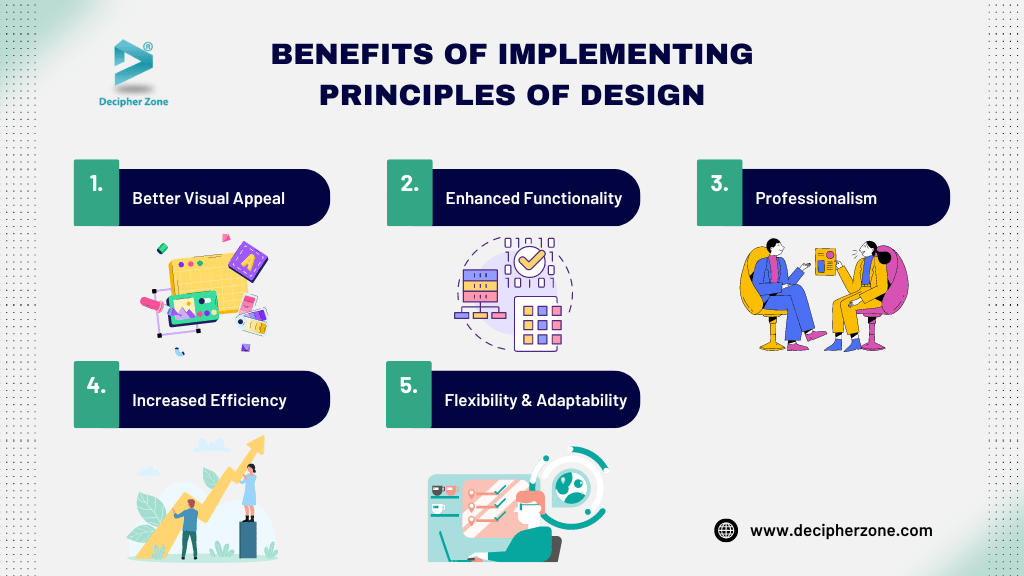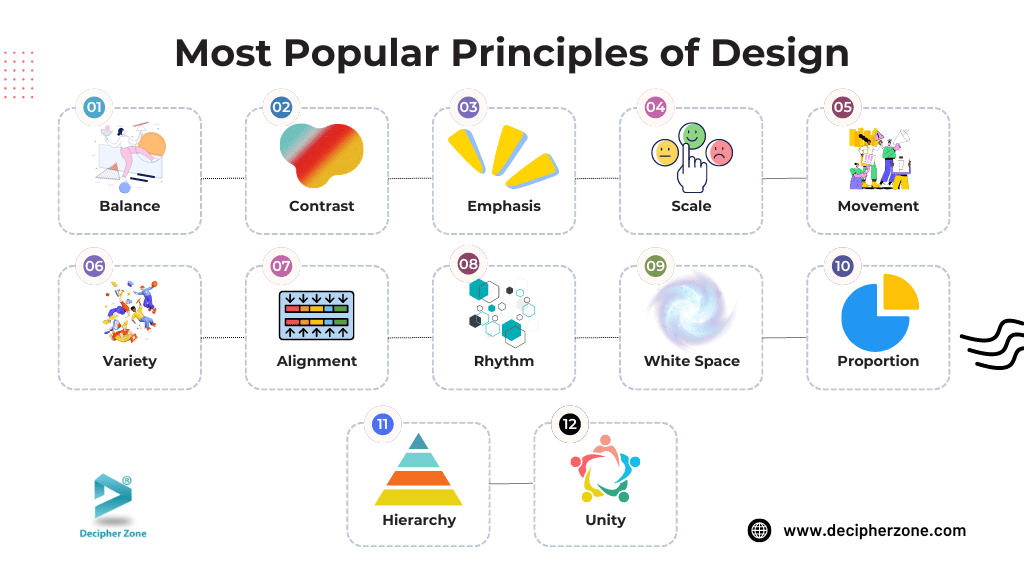In the process of UI/UX design, it's essential to understand and apply various principles of design to create an aesthetically pleasing and functional user interface. By incorporating principles such as balance, contrast, emphasis, rhythm, and unity, designers can improve the user experience and effectively shape users' perceptions of the product or service.
In our everyday lives, from the layout of our office space to the architecture of our cities, from the clothes we wear to the websites we browse, design is an omnipresent force. Have you ever wondered if there are specific guidelines to follow when creating these designs, especially when it comes to the UI/UX of a web/mobile app? Furthermore, are there fundamental principles that can be enlisted to ensure the visual appeal of any designed element?
Read: Course Creation Software Development
To answer all these questions, we'll delve into the various design principles and explore the significance of incorporating them in this blog.
Defining Design Principles
Design principles are fundamental guidelines that assist designers in creating visually appealing and effective compositions. These principles serve as a framework for organizing and arranging various design elements to construct intuitive, aesthetically pleasing, functional, and efficient designs that effectively convey the intended message to the end users. By leveraging these principles, designers can ensure that their creations are not only visually compelling but also convey information and functionality clearly and intuitively.
5 Benefits of Implementing Principles of Design
Implementing the principles of design can offer a wide array of benefits. Some of these include capturing the attention of your audience, creating visually appealing and memorable experiences, enhancing usability and functionality, and fostering effective communication of information and ideas. Let’s look at each of these in more detail below.
-
Better Visual Appeal
-
Enhanced Functionality
-
Professionalism
-
Increased Efficiency
-
Flexibility & Adaptability

1. Better Visual Appeal
The principles of design can greatly enhance the visual appeal of an interface, making it more engaging and attractive. Balancing contrast, variety, and balance in the design can help create a more aesthetically pleasing experience for users.
2. Enhanced Functionality
The impact of good design extends far beyond aesthetics. It plays a pivotal role in optimizing the app's functionality and usability, thus fostering a user-friendly environment. A well-crafted design not only enhances the visual aspect but also elevates the overall functionality, making interactions with the app more intuitive and seamless.
3. Professionalism
A meticulously designed interface is a powerful reflection of professionalism. It underscores the attention to detail put forth by the UI/UX designer, thereby bolstering the brand's credibility and overall perception. Consistency, attention to detail, and a refined appearance all contribute to fostering trust and confidence among users.
4. Increased Efficiency
A strong command of design principles empowers designers to craft creative interfaces with efficiency in mind. This understanding serves as a blueprint, streamlining the design process and leading to faster turnaround times without sacrificing quality.
5. Flexibility & Adaptability
The importance of understanding design principles cannot be overstated due to the flexibility and adaptability it provides. Armed with this knowledge, designers are better equipped to create diverse interfaces that seamlessly adapt to varying formats and serve different purposes, all while retaining a strong, cohesive foundation.
Read: CAD Software Development
12 Most Popular Principles of Designs
Although there is no solidarity within the design community regarding the main principles of design, there are several principles that are frequently mentioned in books and articles.
Therefore, we will list them here for better understanding.
-
Balance
-
Contrast
-
Emphasis
-
Scale
-
Movement
-
Variety
-
Alignment
-
Rhythm
-
White Space
-
Proportion
-
Hierarchy
-
Unity

1. Balance
In design, visual elements have what we call "visual weight," which is similar to the weight physical objects have in the real world. Maintaining balance in this visual weight is crucial to prevent the user's attention from being drawn more to one side of the design than the other.
Achieving this balance involves carefully using shape, position, and contrast. Whether through symmetrical arrangements (with equal-weight items on both sides of a central line) or asymmetrical arrangements (with items of different weights arranged in relation to the center line), achieving balance is essential for creating effective and harmonious designs.
2. Contrast
Contrast is a crucial aspect of design, as it highlights the differences between elements, making each one stand out. It can be achieved through variations in texture, color, shape, and size. Incorporating contrast in design adds visual appeal and creates an engaging spatial dynamic.
3. Emphasis
Emphasis in design refers to the process of making a specific design element stand out from the rest through various visual and interactive techniques, such as adjusting its position, size, color, and animation. When applied correctly, emphasis directs the user's attention to the highlighted element and helps guide their interaction with the design. It is important to use emphasis justifiably, as an excessive amount of emphasis can overwhelm the design and make it less effective in conveying its message or purpose.
4. Scale
Establishing visual connections and defining the overall mood of a design, scale plays a crucial role. It alters the way space and elements are perceived, directing the viewer's attention to specific areas as intended by designers. When manipulated in conjunction with color, texture, and shape, scale has the power to turn a basic design into a captivating story.
5. Movement
The concept of movement in design refers to the way in which a visual composition can direct the viewer's gaze and create a sense of progression or flow. It involves strategically arranging visual elements to guide the viewer's eye throughout the design, leading them to focus on specific areas or focal points. This can be achieved through the use of lines, shapes, colors, and other design elements to create a dynamic and engaging visual experience.
6. Variety
In design, incorporating a variety of elements such as different typography styles, a variety of images, interesting textures, a wide spectrum of colors, and more helps to create visual interest. This prevents the design from appearing monotonous and keeps it engaging and intriguing to the viewer.
7. Alignment
One of the key elements of design is alignment. It ensures a neat and organized appearance, improving designs by connecting different elements. While center, right, or left alignment is common, you can also opt for asymmetry and align text to other objects in your graphic. If something looks off in your design, it’s your sign to check the alignment.
8. Rhythm
Design rhythm can be described as the intentional arrangement of recurring shapes and patterns to establish visual movement. When skillfully employed, it directs the viewer's gaze and generates a feeling of continuity. Rhythm also has the ability to evoke various emotions, ranging from dynamism and serenity to thrill and ease.
Read: 5 Benefits of Using AI for Product Design
9. White Space
White space, also referred to as negative space, provides a distinct perspective to design. It's not about what you add, but rather what you don't add. These white spaces bring a sense of airiness to the design layout, helping to differentiate elements and give them space to stand out. They can also be employed to create emphasis and rhythm within the design.
10. Proportion
Proportion plays a key role in establishing unity, stability, and visual appeal by forming links between various elements. It encompasses not only size but also attributes such as color, shape, and texture. When elements are in sync, they generate equilibrium and steadiness. Disproportionate elements can result in conflict and lack of harmony, so designers must meticulously weigh proportions in their compositions.
11. Hierarchy
When working with multiple visual elements in a design, giving extra visual weight to the most influential aspects is important. The principle of hierarchy in design focuses on organizing elements to draw the viewer's focus to specific areas. Some ways to implement hierarchy in design include using bolder fonts, larger text sizes, unique typography, and placing the most crucial part of the design in a prominent position to draw focus to the main content.
12. Unity
The principle of unity in design is a fundamental concept that emphasizes the creation of a balanced and harmonious composition. It involves ensuring that all the elements within a design work together seamlessly to present a cohesive and visually appealing whole. Designers achieve unity through thoughtful color schemes, complementary textures, harmonious shapes, and the strategic repetition of elements to tie the design together.
Conclusion
The importance of having a good web or app interface cannot be overemphasized. Therefore, it is essential for you as a client to have a solid understanding of design principles along with the UI/UX designers before investing in a project for your business. This understanding will help in creating a customized application that not only meets your business needs but also enhances the user experience.
Read: 3D Character Design
At Decipher Zone, we take pride in our team of professionals who are well-versed in design principles and have years of experience in creating visually appealing and efficient solutions for businesses across various industries. If you are seeking a partner who can assist you in software development without compromising on design, feel free to reach out to our experts today!
FAQs
What is the design principle?
Design principles are fundamental guidelines that assist designers in creating visually appealing and effective compositions.
What are the different principles of design?
Balance, Contrast, Emphasis, Scale, Movement, Variety, Alignment, Rhythm, White Space, Proximity, Proportion, Hierarchy, and Unity are the different principles of design that you can use while crafting a design composition for your website or platform-specific application.
Why are design principles important?
Principles of design are important for capturing the attention of your audience, creating visually appealing and memorable experiences, enhancing usability and functionality, and fostering effective communication of information and ideas.

